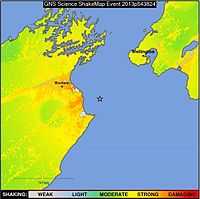2013 Seddon earthquake
 | |
| Date | 21 July 2013 |
|---|---|
| Origin time | 5:09:30 pm NZST |
| Magnitude | 6.5 Mw |
| Depth | 17 kilometres (11 mi) |
| Epicenter | 41°37′S 174°20′E / 41.61°S 174.33°ECoordinates: 41°37′S 174°20′E / 41.61°S 174.33°E |
| Countries or regions |
|
| Tsunami | None |
| Casualties | 4 people injured[2] |
The 2013 Seddon earthquake was an earthquake measuring 6.5 on the moment magnitude scale centred in New Zealand's Cook Strait, around 20 kilometres (12 mi) east of the town of Seddon in Marlborough. The earthquake struck at 5:09:30 pm on 21 July 2013 (05:09 UTC) at a depth of 17 kilometres (11 mi), according to Geonet.[3] The United States Geological Survey also measured the quake at 6.5, at an even shallower depth of 14 kilometres (8.7 mi).[4] The quake caused moderate damage in the wider Marlborough area and Wellington, the nation's capital city 55 kilometres (34 mi) north of the epicentre. Only minor injuries were reported. Several aftershocks occurred during 21–26 July.
The Seddon earthquake is considered the first of an earthquake doublet, with a second earthquake of similar magnitude occurred on 16 August 2013.
Quake

The mainshock followed a series of gradually increasing magnitude earthquakes from a sequence which began two days earlier:[5]
- Magnitude 5.7, 16 km depth, 19/07/2013
- Magnitude, 6.5 17 km depth, 21/07/2013
- Magnitude 5.8, 19 km depth, 21/07/2013
- Magnitude 5.3, 16 km depth, 21/07/2013
- Magnitude 5.0, 16 km depth, 21/07/2013
- Magnitude 4.9, 16 km depth, 21/07/2013
- Magnitude 4.9, 18 km depth, 21/07/2013
- Magnitude 4.8, 10 km depth, 22/07/2013
- Magnitude 4.8, 17m depth, 21/07/2013
- Magnitude 4.9, 10 km depth, 22/07/2013
The earthquake swarm may have occurred on an unmapped fault line. The source fault of the quake is under investigation but potential candidates are the Needles fault, London Hill fault, and/or extensions of the larger faults in the Marlborough Fault System, the Awatere, Clarence, Hope, and Wairau Faults. The geologic (and tectonic) complexity increases as the system moves off the South Island and into Cook Strait. The locations/interactions of the individual faults are not fully understood. There were about 24 known active faults in the Cook Strait and five in the area where the earthquakes occurred. However, the weekend's quakes could have occurred on a new fault yet to be mapped. The faults in Cook Strait are not large enough to generate magnitude-8 earthquakes, but are capable of magnitude 7-7.5 size earthquakes. The weekend's Cook Strait earthquakes would have needed to be at least a magnitude 7.5 to generate a tsunami. However, some coastline around Cook Strait had areas identified as potential landslide risk, and a smaller earthquake could cause a landslide which could then generate a tsunami. This type of tsunami could be quite devastating to the south coast of the North Island and north coast of the South Island.[6]
Damage
The quake resulted in varying degrees of damage to thirty-five buildings within the Wellington CBD with glass from broken windows falling onto the main thoroughfare of Lambton Quay. Damage was also caused in Paraparaumu, Wainuiomata, Porirua and the Hutt Valley in the North Island.[6][7]
The Wellington Region emergency management office was activated on the evening of 21 July, as were those in the lower part of the North Island.[6] On 22 July parts of Wellington's central business district were closed to the public to allow for inspections to buildings with damaged and potentially dangerous façades.[8]
Four people were injured in the quake, which lasted for 20 seconds, blowing out windows, cracking concrete and swaying buildings.[2]
See also
References
- ↑ "M6.5 Cook Strait earthquake ShakeMap". GNS Science. Retrieved 23 July 2013.
- ↑ 2.0 2.1 "Wellington earthquake: We can afford new quake damage - PM". The New Zealand Herald. Retrieved 22 July 2013.
- ↑ "Quakes". GeoNet. Retrieved 21 July 2013.
- ↑ "M6.5 - 46km ESE of Blenheim, New Zealand". USGS. Retrieved 21 July 2013.
- ↑ "Cook Strait aftershocks and forecast probabilities". GeoNet. Retrieved 23 July 2013.
- ↑ 6.0 6.1 6.2 "Wellington earthquakes may have occurred on unmapped fault line". The New Zealand Herald. Retrieved 23 July 2013.
- ↑ Quilliam, Rebecca (22 July 2013). "Wellington earthquake: 35 buildings damaged in CBD". www.nzherald.co.nz. Retrieved 23 July 2013.
- ↑ "Wellington earthquake: What you need to know". The New Zealand Herald. Retrieved 22 July 2013.
| |||||||||||||||||||||||||||||||||||
| |||||||||||
| |||||||||||||||||||||